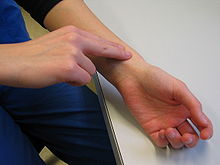Pulse
![]()
This article deals with the medical term pulse. For other meanings, see Pulse (disambiguation).
![]()
This article or subsequent section is not sufficiently supported by evidence (e.g., anecdotal evidence). Information without sufficient evidence may be removed in the near future. Please help Wikipedia by researching the information and adding good supporting evidence.
The pulse (Latin pulsus, "push", as in Latin pulsare "to knock", from Latin pellere "to beat, push") has described since antiquity (for example in the work of the Alexandrian physician Herophilos around 300 BC) the mechanical effects of the pressure and volume fluctuation (pulse wave) originating from the systolic blood ejection from the heart on the immediate surroundings or its transmission to more distant regions of the body through the vascular system.
Pulse refers to both the frequency of the pressure surges that can be detected when counting the pulse (number per minute; for the difference between this pulse frequency and the heart rate, cf. pulse deficit) and its amplitude and course (pulse quality, e.g. "soft", "weak" or "whirring" pulse). In the vascular system, the pulse propagates as a wave with local time courses in each case of the pressure, the cross-sectional area and the volume flow or the flow velocity. A measure of the fluctuations in pulse frequency over time is the pulse variance index.

forearm pulse palpation
Pulse types
A distinction is made between retrograde (backwards, against the blood flow) and anterograde (forwards, with the blood flow) conduction of the cardiac action in the vessels. The retrograde conduction determines the venous pulse (see below), the anterograde conduction the arterial pulse. The arterial pulse receives more attention in medicine than the venous pulse. The pulse provides information about the effectiveness of the cardiac action, its regularity, the rate of pressure increase in the vessels near the heart during systole, the absolute pressure and the filling volume of the vessels.
Pulse Variations
Resting pulse
The resting heart rate (the heart rate (HR) at rest or resting heart rate (RHF)) is 50 to 100 beats per minute in a healthy adult. Sometimes the peripherally palpated pulse is slower than the heart rate on the ECG. This is related to early-onset extra beats that result in a mechanically ineffective cardiac action. This is called a pulse deficit. It is best to measure the resting pulse in the morning after waking up and before getting up.
The resting pulse of a trained endurance athlete is usually between 32 and 45 beats per minute. A resting pulse of less than 30 beats per minute is rarer. The stroke volume and usually also the lung volume of these athletes are increased.
Average resting pulse:
- in human fetuses: approx. 150/min
- for infants: approx. 130/min
- for children: approx. 100/min
- for adolescents: approx. 85/min
- for adults: approx. 70/min
- for seniors: approx. 80/min
Paradoxical pulse
Paradoxical pulse or pulsus paradoxus is the term used to describe an abnormal drop in blood pressure amplitude of more than 10 mmHg during inspiration. It occurs, among other things, with larger pericardial effusions and is considered a sign of impending pericardial tamponade. Furthermore, pulsus paradoxus can be found in the case of an armoured heart, tension pneumothorax and severe asthma attacks.
Pulse pressure or pulse amplitude is the difference between systolic and diastolic blood pressure, i.e. the blood pressure amplitude as a measure of the elasticity of the arteries.
Vein pulse
There is also a weak pulse on the veins. In contrast to the arterial pulse, which is mainly caused by changes in pressure, the pulsation of the veins is mainly caused by changes in their filling state and results in a so-called volume pulse. However, venous flow is dependent on several factors, particularly respiration, body position, and body activity, and not so much on the two-valve venous pulse, which results from changing pressures in the right atrium of the heart. The venous pulse used to be recorded as a jugular vein pulse curve, and today it can be derived relatively easily with a Doppler device at various regions of the body. For this purpose, however, the Doppler frequency must be switched to the low flow velocities in the venous system.
The typical venous pulse curve shows two prominent valleys corresponding to systolic and diastolic inflow to the heart. Only during a short phase is there a brief return flow into the veins, which manifests itself as a small mountain in the venous pulse curve. This return flow corresponds to atrial systole and is called the A wave. However, this short return flow is present only in sinus rhythm and intact mechanical atrial action. In severe tricuspid regurgitation, blood from the right ventricle in systole flows back into the right atrium and upstream veins to a considerable degree, so that the systolic trough of the venous pulse curve is abolished or even reversed to manifest as a mountain.
A very similar venous pulse curve can also be recorded from the pulmonary veins using transesophageal echocardiography (TEE). It can be used to assess the severity of mitral regurgitation.
Search within the encyclopedia